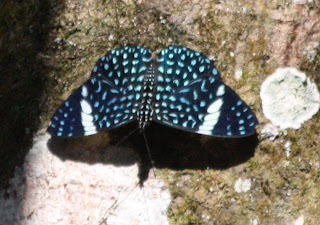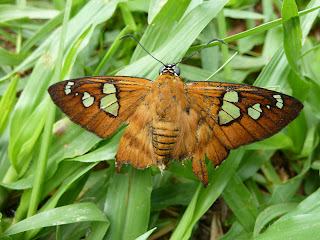 |
| Green-headed Tanager |
So, the last day of our trip, and just time to try one of my
favourite trails again. This time with
beautifully clear skies.
Adilei decided that we deserved a good leg-stretch
before some took the flight home and set off on the most arduous trail we had done so far. We had lots of birds to catch up on and he did his
best to make sure that we got the most out of our last opportunity.
On the drive to the start of the trail we saw Swallow
Tanager, Kiskidee, Cattle Egret, Lesser Yellow-headed Vulture (the last of the
girls’ wish list requirements) and Limpkin.
Saffron finch were flying ahead of the vehicle, Roadside Hawk, Sayaca
Tanager, Blue-and-White Swallow and Campo Flicker all saluted us as we drove
through Matumbo towards the start of the trail.
 |
| Three White-eared Puffbirds |
Scaly-headed Parrots flew over once again, and then perched
in a nearby tree (at last), a good omen for the rest of the walk? Lesser Woodcreeper, Star-throated Antwren,
Red-crowned Ant-Tanager, Black-capped Foliage-gleaner, Ochre-belled Flycatcher,
Violet-crowned Wood-nymph, Blue Manakin, all catch-ups or resightings of new
friends for our intrepid team. A
distant Bellbird called, then a second, and when we played the tape one of the
birds moved, but not anywhere near enough to keep trying. We’ll have to save that for another trip.
Rufous-capped Motmot finally gave in and presented itself to
us in fine fashion, on a cross branch right ahead of us. Great views for all, and very much appreciated. Channel-billed Toucan perched on a far
hillside, much nearer, Olive-green Tanager, Chestnut-bellied Tanager, Plain
Parakeet and Violaceous Euphonia were seen.
Grey-rumped Swift filled the sky, and with the larger
White-collared they made a great picture as they soared and whirled around us.
 |
| Avocado munched by a possum |
After a rather challenging walk, we arrived at a small
clearing where we had great views of
Chestnut-crowned Becard, White-bearded Manakin, Saw-billed Hermit, Green-headed Tanager [the name of this species still causing confusion to some!], Blue-naped Chlorophonia and
Azure-shouldered Tanager. Salvadori’s
Antwren was the bird of the day with great views for everyone. Adilei’s skill in reading the bird and
getting the team just where he thinks they will get the best view is
fantastic. Streak-capped Antwren took
our attention for a short while, but only until Claire spotted a mammal in the
trees above us, a Coati trying to climb up to some bananas, as we watched
another Coati appeared, great views!
 |
| Neotropic Neck |
Back to avian delights and Rufous-bellied Thrush greeted us
on the second half of our loop, White-eared Puffbird, Guira Cuckoo and
Whistling Heron completed the trip list.
So the end to the first part of my trip and unfortunately time for the rest of the group to go home.
Thanks must go to the REGUA team as a whole, but especially to Leonardo and Adilei who helped us to see so many species in our two weeks.
 |
| Sunset over those amazing mountains |










































